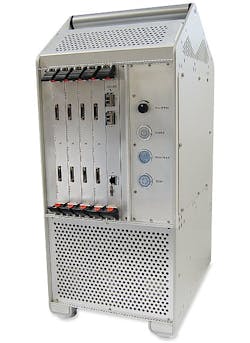Air Force chooses embedded computing from GE for experimental computer that mimics brain processing
Editor's note: GE Intelligent Platforms changed its name to Abaco Systems on 23 Nov. 2015 as a result of the company's acquisition last September by New York-based private equity firm Veritas Capital.
HUNTSVILLE, Ala., 9 Jan. 2014. U.S. Air ForceOfficials of the Air Force Research Laboratory (AFRL) Information Directorate in Rome, N.Y., are awarding a contract to GE for an HPEC system that will enable the development and deployment of advanced neuromorphic architectures and algorithms for adaptive learning, large-scale dynamic data analytics and reasoning, GE officials say.
Neuromorphic computing uses electronic analog circuits to mimic neuro-biological architectures present in the nervous system. It uses analog, digital, and mixed-mode analog/digital computing to run models of neural systems for perception, motor control, or multisensory integration. Some ambitious research projects seek to use neuromorphic computing to reverse-engineer the human brain.
The HPEC system that GE is providing to the Air Force uses graphics processing unit (GPU) accelerators from NVIDIA Corp. in Santa Clara, Calif. The GPU accelerators are parallel processors, and help pull out important information from streaming radar data.
The neuromorphic processor, a project of the AFRL Information Directorate's High Performance Systems Branch, is designed to support the U.S. military's High Performance Computing Modernization Program (HPCMP).
Related: Prospects for high-performance embedded computing (HPEC) look brighter than ever before
Technology from this program will help with next-generation radar programs such as Gotcha wide-area synthetic aperture radar, GE officials say.
The Gotcha wide-area synthetic aperture radar (SAR) is a dual X-band and UHF airborne wide-angle staring radar system for persistent wide-area surveillance. Gotcha radar data is collected in a single-radar mode, and processed into several different data products such as video SAR, ground moving target indication (GMTI) with minimum detectable velocity (MDV), coherent change detection (CCD), super-resolution 2D imagery, and 3D SAR imagery.
Related: Fabric40 program pushes Curtiss-Wright HPEC product throughput to 40 gigabits per second
Air Force researchers envision Gotcha radar processing for persistent surveillance over city-sized areas as large as 6 to 12 miles in diameter, with the capability to see through trees, shrubs, and bushes.
GE's GPU-based HPEC system is housed in a 6U OpenVPX rackmount chassis capable of processing data as quickly as 20 trillion floating point operations per second (teraflops). The system is scalable and can be expanded to include additional racks and compute nodes, GE officials say.
"This embedded system provides a path forward to apply large-scale neuromorphic computing models for Air Force's state-of-the-art ISR platforms and systems," says Mark Barnell, a senior computer scientist at AFRL.
The GE HPEC system is a modular embedded computer with racks that contain five of GE's SBC625 single-board computers with quad core Intel Core i7 processors, and RDMA-capable Mellanox 10 Gigabit Ethernet/InfiniBand adapters.
Related: DARPA aims at increasing embedded computing power efficiency from 1 to 75 GFLOPS per Watt
The single board computers are coupled with modules with NVIDIA GPU accelerators based on the NVIDIA Kepler computing architecture, delivering 13,440 cores. Inter-board communication is achieved via GE's 20-port IBX400 InfiniBand switch.
For more information contact GE Intelligent Platforms online at http://defense.ge-ip.com, or the Air Force Research Laboratory Information Directorate at www.wpafb.af.mil/afrl/ri.

